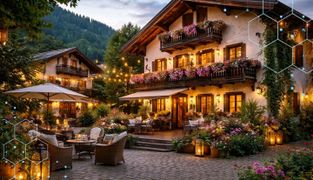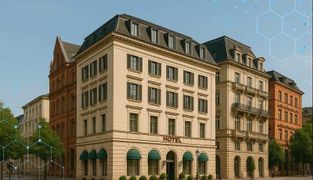Building a viable financial strategy and setting goals are two major keys to a thriving business. If you want to estimate the hotel’s success and decide on the vectors of further development, you need precise data. The numbers do not lie, and to get those numbers, hoteliers usually turn to special metrics.
To put it simply, metrics are the tools for measurement of your property’s efficiency. The calculated result will be KPI, which means a Key Performance Indicator. It is used to benchmark the efficiency of efforts put to achieve a certain goal. Knowing it means knowing your weaknesses and the potential ways of improvement.
The idea of hotel performance is complex and has many aspects. And it is so important because it determines not only the profit flow but also the behavior of employees. This is why the system of its measurement should match the main objectives of your company.
It might seem like a big deal, but tracking relevant KPIs is not a problem at all. With the Property Management System, you will always have fast access to all data needed for the calculation.
In this article, you will find a short overview of the essential metrics to track, and well as several recommendations on how to improve the overall performance of your establishment.
Basic formulas to measure hotel performance
Before we dive into the world of more advanced calculations, let us cover the basics. We will start with KPIs, which are quite easy to count. These are the ones associated with revenue flow and occupancy:

Average Daily Rate (ADR)
The ADR indicator helps you to find out the average sum paid by guests per room for an exact timespan. It allows you to assess the financial wellbeing of your property by showing the average income, generated by sold room on any given day.
Growing ADR means that you succeed in earning more revenue from the rent. To increase this figure, hoteliers must find new ways of improvement and boost the rate of the room.
Calculation
ADR = Total Rooms Revenue / Number of Rooms Sold*
* Note that you should exclude complimentary rooms, as they do not have an exact value to add.
The reasons to track ADR
Here is why every hotel owner has to pay attention to this indicator:
● It gives you a chance to compare your hotel with the other ones;
● It helps you to come up with the minimum ADR you need to get the maximum possible profit.

Occupancy Rate
This is a KPI that reflects the percentage of rooms occupied over a certain amount of time. It will tell you how filled your hotel is at any given period.
Obviously, the more rooms you sell, the more income you can expect. Guests usually pay not only for accommodation but also for meals, pool, parking, etc. Nevertheless, filling all available rooms shouldn´t be your main goal, as there must be a nice balance between the yield and costs.
Calculation
Occupancy Rate = Paid Rooms Occupied / Rooms Available
or
Occupancy Rate = Revenue per Available Room / ADR
The reasons to track the Occupancy Rate
It may appear that the more guests come for a stay, the better. Moreover, you may think that it is not necessary to ascertain the exact rate. But this is why tracking OR is a must:
● It provides statistics that will show the occupancy during a certain season;
● It can help you to adjust operational spendings and make sure that you have enough resources to run the business when all rooms are occupied.

Revenue Per Available Room (RevPAR)
RevPAR is one of the most widely used KPIs in the hotel industry. It provides clear evidence of your progress in selling rooms and growing revenue. This indicator seems almost identical to the ADR, but here you include all accessible rooms, even non-occupied ones.&
Consequently, growing RevPAR can signal about raising of your Average Daily Rate or Occupancy Rate. To sum up, it reflects the median revenue that you receive from each room.
Calculation
RevPAR = Room Revenue / Number of Rooms Available
or
RevPAR = Average Daily Rate x Occupancy Rate
The reasons to track RevPAR
So, why should you pay attention to this indicator?
● To brainstorm the ways of ameliorating your revenue management, if you are not satisfied with your RevPAR;
● To see whether you correctly meet your goals concerning Occupancy Rate / ADR, or not.
Advanced financial metrics for your success
Nonetheless, these metrics will not show you everything. The disadvantage of RevPAR consists in failing to take general profit into account. While hotels are able to generate earnings from their amenities as well.
It also does not consider whether your property is big or small. When comparing your RevPAR to your competitors’, note that yours may have a lower figure, but possess more rooms with a higher price.
To get a complete grasp of your state of affairs, you need to combine RevPAR with Key Performance Indicators, such as GOPPAR, TrevPAR, and ARPAR.

Gross Operating Profit Per Available Room (GOPPAR)
This formula allows you to evaluate the amount of income, which you got from all available sources. It pays attention to the profits gained from rooms and services, plus supplementary costs. Thus, GOPPAR shows the performance of your business at large.
Calculation
GOPPAR = Gross operating profit / Total rooms available
The reasons to track GOPPAR
This point explains why you should not ignore the index mentioned above:
● Tracking GOPPAR with other KPIs gives you the advantage of seeing an objective reality and setting accurate rates to get the maximum of revenue.

Total Revenue Per Available Room (TrevPAR)
TrevPAR is another important KPI that can show what is what. It includes income from all sources as well. But unlike GOPPAR, it neglects cost factors and Occupancy Rate.
TrevPAR is an essential metric for hotels that generate the major part of their income not only from apartments, but also from other large components of their business.
Calculation
TrevPAR = Total Revenue / Total Number of Rooms
The reasons to track TrevPAR
If you are still wondering whether you should apply this metric or not, remember:
● It is an essential formula for hotel owners and managers since this KPI offers a high-level view of your hotel performance.

Adjusted revenue per available room (ARPAR)
ARPAR is a convenient KPI, which can show whether your revenue strategy has been successful, or not. It can also help you to estimate the effectiveness of your hotel’s current pricing policy. ARPAR differs from all metrics above by taking into account variable costs and additional revenue streams at the same time.
These variable costs are, for example, energy and water usage, and various supplies. ARPAR excludes them from the calculation, showcasing net revenue generated by each occupied room.
Calculation
ARPAR = (ADR – CPOR + POS Revenue per occupied room) x Occupancy
or
ARPAR = (Room Revenue – CPOR x Occupancy + POS Revenue) / Rooms Available
Why you should track ARPAR
One of the main reasons to add ARPAR to your business plan is the following:
● ARPAR is a tool that reflects a full picture concerning “bottom line profit”. It is more precise than RevPAR or GOPPAR and evaluates the efficiency of your financial strategy.
How to improve your KPIs with automated technologies
The number of metrics that you should track to measure your hotel’s financial performance may seem overwhelming. Yet, these calculations are highly rewarding since they help hotel managers to recognize which part of their business strategy needs adjustment. Or, they may serve as useful tools for achieving certain goals concerning income and occupancy rate.
In any case, using these metrics is essential if you want to increase profit and decrease costs. While looking for ways to boost your KPIs, consider implementing cloud-based automated technologies. This is the easiest way to enhance customer experience and, consequently, get more bookings all year round.
Here are 5 effective tips for improving your indexes with cloud-based technologies
#1 Prioritize guest experience
Along with financial KPIs, there are also non-financial ones. The most important of them is called “customer satisfaction”. It cannot be calculated in the usual way with formulas, but it has a direct impact on the overall performance of your property.
Thus, if you want, for example, to raise ADR, then you should provide impeccable service delivery and develop upselling strategies. The latter means providing additional services to guests, as a way to upgrade their experience and raise profits.
To achieve this with no extra costs, we recommend implementing technologies. For example, the Concierge App allows ordering room service and setting the exact time and place of delivery. Thus, if customers want to enjoy their vegetarian dinner on the terrace with a view, they have a tool to fulfill this desire. Plus, effortless paying for services with their mobile phones will add to the satisfaction level, and then convert into positive reviews and repeat visits.
In the realities of a highly competitive market, it is crucial to showcase your customers what features make your hotel unique, as well as describe what you suggest for their trouble-free stay. For instance, it may be a fast Check-In/Check-Out option, which allows guests to skip queuing up at the reception desk after they arrive. If you succeed in setting your business apart with features that cannot be found anywhere else, you will drive demand and KPIs.
#2 Offer special deals and promotions
If your primary goal is to increase Occupancy Rate, promotions and packages will draw more customers to your place. It is more likely that potential clients will choose to save money on a good deal than pay for a room without any complimentary services. Besides, the fear of missing a great price plays an important role while customers decide on booking.
Creating such offerings is easier with Deal Manager. This time-saving tool is a simple constructor, which allows making your own vouchers, combining rooms and services. All you need to do is add several services of your choice to an overnight stay and set an attractive rate. Then customers will be able to purchase the deal on the web or through the mobile app.
Yet, remember – when creating a special package, do not slash prices dramatically! You will not gain any profit if your hotel is full and prices are extremely low. Instead, aim for strong pricing for your rooms, mixing it with pleasant features that add value to the deal.
#3 Use Channel Manager software
Another way to improve both the income and occupancy is by reaching customers via Online Travel Agencies. OTAs, such as Booking.com are extremely popular platforms, which make a great supplement to direct bookings from your hotel’s website.
Using Channel Manager will help you to control an unlimited number of channels simultaneously. When customer books a room, its status changes to unavailable on all other connected platforms, protecting your hotel from overbooking. And, thanks to the synchronization with PMS, all changes concerning rates and restrictions will be updated automatically across every channel just after you submit them!
Implementing this way of advertising your property is highly efficient, as it can attract a larger audience. Obviously, the financial health of your hotel will skyrocket.
#4 Encourage direct bookings with social media platforms
OTAs are highly effective when it comes to boosting occupancy rate, however, they often charge high commissions. Thus, you should look for some ways to increase the number of direct reservations. Using a Booking Engine is a great solution in this case.
To convince customers that your hotel is exactly what they are looking for, the booking process should be easy. HotelFriend offers an intuitive interface that simplifies every step of it. After clicking on the button, the guest can select dates, the type and rate of the room, or even order services and deals in advance.
The next step in this approach is promotion via Facebook, Twitter, or Instagram. The choice of a suitable platform depends on the type of your hotel and your target audience. For example, if you offer a stay in a quiet area with a spa and fitness center, consider choosing FB. Why? Because it is mostly used by middle-aged women, who may be your main customers. You can use special Marketing Tools while building an SMM strategy for your hotel.
#5 Establish strict cancellation policies
As it was mentioned before, a fully booked hotel does not necessarily mean loads of income. You should aim not for the highest Occupancy Rate, but rather for higher RevPAR. To achieve this, try to use demand forecasting. It will allow you to plan ahead and pick the right prices after you analyze your previous mistakes.
But there will be no use from this approach if your cancellation policy is too lenient. Accurate forecasting is impossible when your business experiences a high number of late cancellations. The best way to safeguard your future profits is by applying stricter cancellation policies.
For example, with the Room Rate module of the property management system, you can set your reservations to “non-refundable”, or add your own variants (i.e. charging a fee). Correct demand forecasting is a strong foundation for your business strategy and a great way to grow your bottom-line income.
Conclusion
No matter how big your hotel is, tracking these metrics may remarkably improve its financial performance. Successful hotelier knows that investing in automated technology is the best way to both boost revenues and meet customer expectations.
And now, armed with knowledge about the most important KPIs and the ways of improving them, you are ready to move towards your goals. Use our tips and recommendations for strengthening your KPIs and enjoy the thriving of your business.
Public relations: Stephanie Moench




